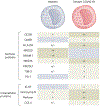Defining the role of natural killer cells in COVID-19
- PMID: 37460639
- PMCID: PMC10538371
- DOI: 10.1038/s41590-023-01560-8
Defining the role of natural killer cells in COVID-19
Abstract
Natural killer (NK) cells are critical effectors of antiviral immunity. Researchers have therefore sought to characterize the NK cell response to coronavirus disease 2019 (COVID-19) and the virus that causes it, severe acute respiratory syndrome coronavirus 2 (SARS-CoV-2). The NK cells of patients with severe COVID-19 undergo extensive phenotypic and functional changes. For example, the NK cells from critically ill patients with COVID-19 are highly activated and exhausted, with poor cytotoxic function and cytokine production upon stimulation. The NK cell response to SARS-CoV-2 is also modulated by changes induced in virally infected cells, including the ability of a viral peptide to bind HLA-E, preventing NK cells from receiving inhibitory signals, and the downregulation of major histocompatibility complex class I and ligands for the activating receptor NKG2D. These changes have important implications for the ability of infected cells to escape NK cell killing. The implications of these findings for antibody-dependent NK cell activity in COVID-19 are also reviewed. Despite these advances in the understanding of the NK cell response to SARS-CoV-2, there remain critical gaps in our current understanding and a wealth of avenues for future research on this topic.
© 2023. Springer Nature America, Inc.
Conflict of interest statement
Competing interests
C.A.B. reports compensation for consulting and/or SAB membership from Catamaran Bio, DeepCell, Immunebridge, Sangamo Therapeutics and Bicycle Tx on topics unrelated to this review. M.J.L. declares no competing interests.
Figures




Similar articles
-
SARS-CoV-2 escapes direct NK cell killing through Nsp1-mediated downregulation of ligands for NKG2D.Cell Rep. 2022 Dec 27;41(13):111892. doi: 10.1016/j.celrep.2022.111892. Epub 2022 Dec 12. Cell Rep. 2022. PMID: 36543165 Free PMC article.
-
Siglec-9 Restrains Antibody-Dependent Natural Killer Cell Cytotoxicity against SARS-CoV-2.mBio. 2023 Feb 28;14(1):e0339322. doi: 10.1128/mbio.03393-22. Epub 2023 Feb 2. mBio. 2023. PMID: 36728420 Free PMC article.
-
Elevated levels of cell-free NKG2D-ligands modulate NKG2D surface expression and compromise NK cell function in severe COVID-19 disease.Front Immunol. 2024 Feb 12;15:1273942. doi: 10.3389/fimmu.2024.1273942. eCollection 2024. Front Immunol. 2024. PMID: 38410511 Free PMC article.
-
Natural Killer Cells in SARS-CoV-2 Infection: Pathophysiology and Therapeutic Implications.Front Immunol. 2022 Jun 30;13:888248. doi: 10.3389/fimmu.2022.888248. eCollection 2022. Front Immunol. 2022. PMID: 35844604 Free PMC article. Review.
-
Natural killer cell exhaustion in SARS-CoV-2 infection.Innate Immun. 2022 Aug;28(6):189-198. doi: 10.1177/17534259221077750. Epub 2022 Jun 22. Innate Immun. 2022. PMID: 35733383 Free PMC article. Review.
Cited by
-
Natural Killer Cell Ligands: Another Source of Heterogeneity in Acute Lung Injury Pathophysiology?Am J Respir Crit Care Med. 2024 Jan 1;209(1):8-10. doi: 10.1164/rccm.202311-2033ED. Am J Respir Crit Care Med. 2024. PMID: 38099728 Free PMC article. No abstract available.
-
Natural killer cell responses during SARS-CoV-2 infection and vaccination in people living with HIV-1.Sci Rep. 2023 Nov 3;13(1):18994. doi: 10.1038/s41598-023-45412-9. Sci Rep. 2023. PMID: 37923825 Free PMC article.
-
Natural Killer Cells and Cytotoxic T Cells: Complementary Partners against Microorganisms and Cancer.Microorganisms. 2024 Jan 22;12(1):230. doi: 10.3390/microorganisms12010230. Microorganisms. 2024. PMID: 38276215 Free PMC article. Review.
-
The causal effect of natural killer cells on COVID-19 infection, hospitalization and severity.Inflamm Res. 2025 Feb 13;74(1):37. doi: 10.1007/s00011-024-01967-5. Inflamm Res. 2025. PMID: 39945857
-
Distinct platelet transcriptomic heterogeneity in respiratory illnesses and modulation by corticosteroids and immune antibody treatments.J Transl Med. 2025 Aug 19;23(1):935. doi: 10.1186/s12967-025-06845-0. J Transl Med. 2025. PMID: 40830975
References
Publication types
MeSH terms
Substances
Grants and funding
LinkOut - more resources
Full Text Sources
Medical
Research Materials
Miscellaneous

